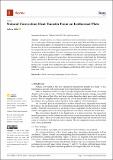Natural Convection Heat Transfer from an Isothermal Plate
Author(s)
Jaffer, Aubrey
Downloadthermo-03-00010-v2.pdf (568.6Kb)
Publisher with Creative Commons License
Publisher with Creative Commons License
Creative Commons Attribution
Terms of use
Metadata
Show full item recordAbstract
Using boundary-layer theory, natural convection heat transfer formulas that are accurate over a wide range of Rayleigh numbers (<i>Ra</i>) were developed in the 1970s and 1980s for vertical and downward-facing plates. A comprehensive formula for upward-facing plates remained unsolved because they do not form conventional boundary-layers. From the thermodynamic constraints on heat-engine efficiency, the novel approach presented here derives formulas for natural convection heat transfer from isothermal plates. The union of four peer-reviewed data-sets spanning <inline-formula><math xmlns="http://www.w3.org/1998/Math/MathML" display="inline"><semantics><mrow><mn>1</mn><mo><</mo><mi>R</mi><mi>a</mi><mo><</mo><msup><mn>10</mn><mn>12</mn></msup></mrow></semantics></math></inline-formula> has 5.4% root-mean-squared relative error (RMSRE) from the new upward-facing heat transfer formula. Applied to downward-facing plates, this novel approach outperforms the Schulenberg (1985) formula’s 4.6% RMSRE with 3.8% on four peer-reviewed data-sets spanning <inline-formula><math xmlns="http://www.w3.org/1998/Math/MathML" display="inline"><semantics><mrow><msup><mn>10</mn><mn>6</mn></msup><mo><</mo><mi>R</mi><mi>a</mi><mo><</mo><msup><mn>10</mn><mn>12</mn></msup></mrow></semantics></math></inline-formula>. The introduction of the harmonic mean as the characteristic length metric for vertical and downward-facing plates extends those rectangular plate formulas to other convex shapes, achieving 3.8% RMSRE on vertical disk convection from Hassani and Hollands (1987) and 3.2% from Kobus and Wedekind (1995).
Date issued
2023-02-03Publisher
Multidisciplinary Digital Publishing Institute
Citation
Thermo 3 (1): 148-175 (2023)
Version: Final published version